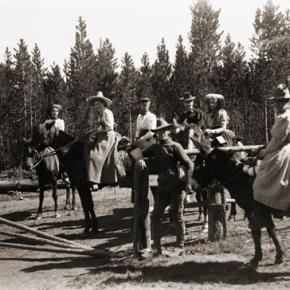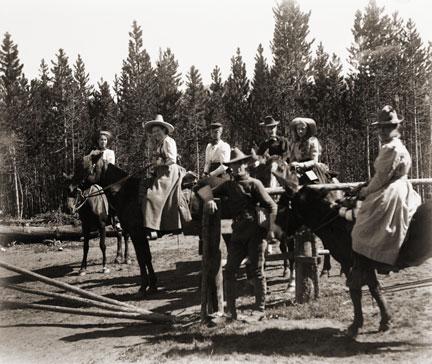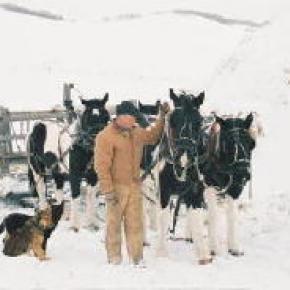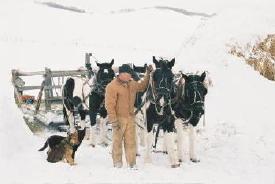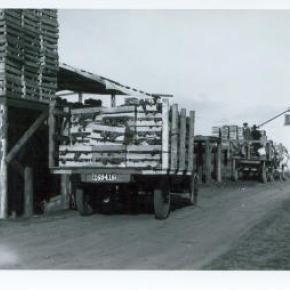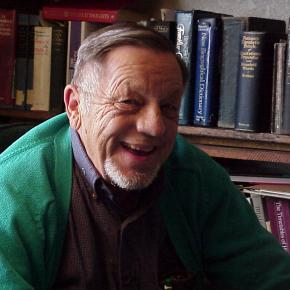Community Life Articles
| The Rocky Mountain National Park |
The Rocky Mountain National Park
Poem contributed by Vera Shay, July 2006 Once you've been there It'll be your most favorite anywhere The beauty up through the trees It's bound to please From May through September Sights and Sounds you will remember Deer and moose grazing on meadows so green All in their splendor to be seen You will return again and again In the fall just heat the bugle-call Of the elegant, determined elk so strong Choosing his mate to follow him along Mountain lion and even brown bear are there They you might hope to only from afar Or the windows of your car The Grand Lake Lodge in the park Cabins looking so cozy and fun A plan my husband and I to spend the night We didn't get it done In the Lodge Restaurant we had dinner A many a time With food so fine My birthday dinner, year after year With happiness and cheer Yes this is a park to yourself and your friends you say I love this park any summer day The For me many memories in this park
|
| The Selak Hanging |
The Selak Hanging
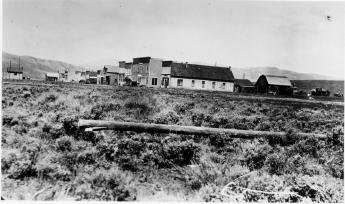
Fred Selak was a descendant of early settlers in Grand County. He built a cabin three miles south of Grand Lake where he lived alone. He helped his brothers in various enterprises including mining, a general store and a sawmill. Selak was known to be a prosperous citizen who lent money to others and there were rumors of hidden cash and gold in his cabin. He was also known to be an avid coin collector. When Selak failed to pick up his mail for several weeks, the postmaster visited his cabin July 26, 1926. After not getting a response to his knocks, the postmaster summoned an employee of Selak's with a key. When they opened the door, they discovered the cabin in shambles and Selak missing. Sheriff Mark Fletcher was notified and a nephew of Selak's called in the Denver Police Department. As the investigation progressed, a .22 caliber slug was extracted from the wall and blood was found on an easy chair, but further investigation ruled these clues inconsequential as they were dated to many years prior. Sheriff Fletcher conducted a massive manhunt on August 16th and the body of Fred Selak was found on the second day by a deputy's dog. The body was hanging from a tree and evidence showed that, because of a sloppy knot, Selak did not die quickly of a broken neck but rather suffered a slow strangulation. The murder had taken place a month earlier and the body had stretched until the feet were touching the ground. Arthur Osborn, 22, and his cousin Roy Noakes, 21, became prime suspects after showing off old coins and trying to spend them for minor purchases around Grand Lake. After interrogation by the Denver Police, both confessed to robbing and killing Selak. Later, Noakes claimed that the confessions were coerced by the police. The suspects were kept in the Denver jail until their trial on March 7, 1927 and Sheriff Fletcher had to take great precautions against a possible lynching. The only motive for the murder seems to be based on a land dispute years earlier in which Osborn was arrested for a violating fence line. Both suspects were found guilty and sentenced to death. After many appeals, the convicted murderers were hung in Canon City on March 30, 1928. |
| Welcome to Middle Park and Grand County! |
Welcome to Middle Park and Grand County!
Story Contributed by Jean Miller Sam Conger worked long and hard in 1861, panning for gold along Coon Track Creek east of Colorado¹s Continental Divide; his findings encouraged him to follow the creek on up to 9800’. Arapahoe Indians of that area told him about their “Treasure Mountain” and when the government moved the Indians out, Sam resolved to explore. By the summer of 1869, he and five partners had found silver, enough to stake out the Caribou and Conger mines. A year later, the little town of Caribou was established to house miners that flocked in. Hopes were high and Caribou City soon had a church, three saloons, a brewery, and a newspaper to provide for the 400 people who lived there. Eventually, this district produced an estimated $8 million before closing in 1884, enough to give rise to Colorado’s being dubbed the “Silver State.” The area also became known as “The Place where Winds were Born,” for it was always windy, with plenty of snow to go with it. In September 1879, nearly the entire town went up in flames. Among those who lost their homes and belongings were Ben and Laura Simpson. The couple and their children found a place in the budding town of Nederland, where they stayed for six months while they decided what to do. Although the town was soon rebuilt for a population of 549, the Simpsons weren’t sure they even wanted to remain. Ben told his wife, “I’m thinking I’m not really cut out to be a miner. I reckon I’d like farming or ranching better.” Word was that Middle Park, west of the Divide, had fine open meadows, ranch land, and plenty of water. “That sounds hopeful,” commented Laura. But how to get there was another question. To the north no roads existed, all the way to Wyoming. Indians sometimes entered the Park by way of the Milner Pass area or over Flattop Mountain, but that was a long way from Caribou. To the south, the Crawford family, in 1874, had used a road of sorts, built by J.Q.A. Rollins; but that too was a long way from Caribou. Berthoud Pass also had been opened in 1874, but that was even farther to travel, and walking was the only choice the Simpsons had. As it was, several trips would be necessary to get their meager possessions all moved. However, Ben had heard of a closer Indian trail that led over Buckhannon Pass (sic). Simpson knew that there was fairly flat country between Caribou and a branch of St. Vrain Creek, which drained from Buchanan Pass and was closer at hand. “We’ll go that way,” said Ben. “I figure we can make it one way in a week or so, at least, if we don’t get lost.” Now, what we call “Buchanan” Pass and Creek today is supposedly named for James Buchanan, the pre-Civil War president, who was also president when Colorado Territory was created. Be that as it may, early maps of Colorado, including Hayden’s 1877 Atlas, don’t name the pass at all and it’s uncertain if, in fact, this is so. July was well along when the family packed the first load of their belongings, along with food that wouldn’t spoil. They headed out, the children driving or leading their stock. Chickens were confined in coops, lashed to horses’ backs and the pigs in crates, to mules. Progress was not difficult to start with, though it was slow, for Ben often had to scout on ahead. He had only a very sketchy map and there were no roads to follow. Still, the family was glad to stop a bit and rest and to let the animals graze. It took most of three days to reach the St. Vrain and locate the rumored Indian trail. Tall aspens and pines crowded the forest here and the ground vegetation was thick, with large boulders scattered everywhere. “Keep those critters moving,” Simpson told the children. “Don’t let them wander. I want to get to the top of the pass today, if we can.” Pines gradually gave way to moss-festooned spruce, but finally, the faint trail left the forest and opened onto bare, glacially-carved terrain with spectacular views of what today we call Indian Peaks, rugged, with sheer cliffs, surrounded by huge boulders. Even though t was mid-summer, they met drifts of deep snow as they climbed higher and they had to pick their path through the wet and slop. The horses and mules plunged and pawed their way through, chickens squawking frantically and pigs grunting uneasily. The final stretch of the narrow path was steep enough that they had to make several switchbacks up the rock face to the tundra on top, almost 12,000’ high. A chill wind quickly dried their sweaty faces, and everyone was happy to stop for a breather. The view was stunning; Sawtooth Mountain towered to the southeast, with its flat summit and sharp drop-offs on three sides. Alpine grasses and flowers of the most brilliant colors grew between flat lichen-covered boulders atop the crest. The animals fell to grazing eagerly while the Simpsons looked west towards what would be their new home. Soon, though, Laura said, “Let’s move on down, Ben. I¹m getting chilled, and I see a thunderstorm building over that way. I don’t want that to catch us on top here. They scare me.” So the little group moved down the easy tundra slope leading northwest, until they spotted the descending trail. This soon dropped steeply to a bench. Here and there the spruce forest opened to meadows, soggy with melting snow and filled with little creeks, tarns, and abundant flowers. Parallel to their route, Buchanan Creek gained momentum as it plunged downward, and whenever the canyon narrowed, the immense amount of water crashed and tumbled over the large boulders, creating a tremendous and frightening roar. “Don’t anybody get near that creek,” cried Ben. “If you fall in, we’d never get you out!” When the Simpsons saw that the trail, such as it was, seemed to split, they chose to go right, which seemed more moderate. “That creek spooks me, with all its noise,” said Laura. The forest was lodgepoles and aspens now and everyone was pleased when they came to a large, deep lake with boulders surrounding the water’s edge; they heard later this was Gourd Lake. “Shall we camp here,” suggested Ben? “No,” said the children. “It’s too wet!” On they trudged then, down another very steep drop, switchbacking through the trees as well as they were able. At last, scrambling over unstable, loose rock, they reached the valley where another large stream cascaded down on the left, to join Buchanan Creek. The way eased and the valley gradually opened until finally, to everyone¹s delight, a huge park appeared, with meadows filled with grass turning golden in the summer sun, sparkling streams, and kindly hills surrounding all. The end of their trek was at hand. Just then Laura spotted a rider on the far side of the meadow. The man turned out to be Henry Lehman, a recent homesteader and rancher, one of only three in the area. “Welcome to Middle Park and to Grand County,” he cried. When he heard who they were and where they had come from, he said, “Stay the night with us. My wife will be delighted to have company; she sees so few people.” The Simpsons were overjoyed at such a welcome. Then Henry added, “You can rest with us a few days and leave your things here until you have fetched your other belongings. We can talk about where you might settle and even help you build a cabin before winter.” Thus it was that Ben and Laura Simpson found a new home in this green oasis of Middle Park. Sources: Louisa Ward Arps: High Country Names,GCHA Journals:1982 The Journey 1987 Indians of Middle Park, 1985 Ranching and Ranchers Henry Lehman, Deborah Carr, Hiking Grand CountyTrails and other hiking experts, Robert C. Black III, Island in the Rockies &l ;/P> <
|
| Welcome to the Modern World |
Welcome to the Modern World
Article contributed by Jean Miller Karl and Adella Just homesteaded on Pole Creek in the Fraser River Valley in 1896. Della was the daughter of Henry Lehman, who had, himself, homesteaded on the upper Grand River about 1880. Karl and Della worked hard, adding to their property until by the late twenties, they had the largest holding in the valley. This lovely ranch was where Snow Mountain Ranch is now, and their log home still stands there even today. Their several children homesteaded in their own rights. Della and her son Alfred had what is known as the Rowley homestead, (now part of the Y-Camp) as well as what currently is the Winter Park Highlands. Son Rudy and his wife Clarabelle ranched part of the original Just property on Pole Creek where they watched over his mother. Another daughter married one of the Daxton boys and their spread was on Crooked Creek. Until the 1950's, just beyond Tabernash on the north side of the highway at the foot of Winter Park Highlands stood one of the original log homes of this family. In fact, this house appeared in a 1952 movie called "On Dangerous Ground", starring Ida Lupino, Robert Ryan, and Ward Bond. It was torn down some years later and a modern house built there. Life was hard for ranching pioneers, perhaps hardest of all for the women, for they worked in the fields and of course, did all the work of the house as well as much of the garden work. Little Della raked hay during the season, hoed gardens, hauled water, fished, sewed, and cooked. She was tough. The bright spots were when rare visitors stopped by, or as the population increased, dances were held in one town or another. It was a given that the Just home, like those of most pioneers, had no indoor plumbing. Nobody expected it and nobody complained. However, by 1957, Della Just was in her nineties. Karl was long gone. Her children decided that she should have indoor plumbing after all these years, and they heard that young Dwight Miller had a brand new backhoe. When they called, Dwight was pleased at the thought of doing such a useful job. He brought his machine out to the ranch and prepared to get to work. He discovered, however, that there was disagreement on this bright idea. Della thought the notion was silly. "I've lived all these years with an outhouse and I don't see any reason at all to change!" Back in those days, temperatures were very much colder than those currently expected. Forty and fifty degrees below zero were not unusual at all. But that old lady didn't mind this. (No doubt, there were chamber pots available for the worst weather.) Della's children, themselves no longer young, won out, and Dwight dug the trenches and the septic tank hole and laid the pipes. We never heard whether Della got used to such luxury or not, but we know that Rudy and Clarabelle agreed that moving into the modern world was a good idea! |
| Who Started the Museum? |
Who Started the Museum?
Article contributed by Jean Miller Many years ago, as in the beginning of the 20th century, the early Grand County pioneers worked, socialized, raised families, and developed sturdy towns such as Hot Sulphur Springs. Many of them gathered information about county citizens, but of all these, probably Daisy Button created the most comprehensive resource over the decades. Daisy and her brother Horace lived with their parents, Schuyler and Josephine, on a small ranch at the foot of Cottonwood Pass on the east side. Among other things, the family operated the toll gate, collecting fees from travelers going to Hot Sulphur. Eventually the Buttons moved into town and, Later, Daisy, married Charles Jenne. Daisy was one of those people who had a real feel for what information was the most useful to save for the future. She collected obituaries (one of the most valuable of all tools for historical reference). She cut out articles on politics, new businesses, town events. She kept programs, fliers, political announcements, menus, and dance cards. Then in 1919, the first and second waves of Grand County pioneers created the Pioneer Society. At first it was mostly a social group, but as the old-timers started to die off more quickly, their children realized they should start keeping records of the settlers and their doings. Who had a large and extensive set of scrapbooks, telling all about the early days, but Daisy Jenne! The original Courthouse in Hot Sulphur stood about where the County Jail is now. When the "new" Courthouse was built, the old building's space became available for the Pioneer Society to use as a museum. Daisy moved her collection of artifacts over there. Others donated household or personal articles. So the little museum came to life, with Daisy as its primary caretaker. There was a core of folks from the area who, over the years, helped her and who took over after she died. There was John Sheriff, whose mother had homesteaded on the Grand River just east of "Potato Hill", coming from Leadville after her husband died. John's wife Ida (Marte) was a key person; her family had come from Austria to homestead east of Cottonwood Pass on Eight Mile Creek. Manny Wood, part of a huge homesteading family on the Williams Fork, pitched in, along with his wife Henrietta (Bode), whose family settled on Corral Creek. And there was Paul Gilbert, long time head of the Fish and Game Dept. in the county. Paul was a fine photographer. For many years, he took photos of historical sites and people, and he also reprinted old pictures, all of this for the Pioneer Museum. If it weren't for Paul, the Grand County Museum would not be able to boast of its very excellent and extensive collection of photos today. As Colorado's Centennial Year (1976) approached, Regina Black and her husband Bob thought that there were so many newcomers who were not of pioneer stock, but who were very interested in the history of the area, perhaps a new organization could be formed to accommodate these folks. Bob had already written Island in the Rockies in 1969, published by the Pioneer Society. This book basically became the "bible" for county pioneer history. So Reggie put notices in the paper, announcing a meeting at their home, to discuss possibilities. She expected 10 or 15 people maybe. Some 60-70 showed up! The need was great. By this time, a small addition had been built at the rear of the old courthouse, to hold the Hot Sulphur Library. I was on the library board at that time. I remember well how the museum collection was growing and the library collection was growing; and we library folks kept encroaching on museum space. We never came to blows, but we thought about it! The upshot of Reggie's effort was the creation of the Grand County Historical Association, an umbrella organization intended to support all historical efforts within the county. The group sought and received a Centennial Grant that allowed them to go to the East Grand School Board and negotiate the transfer of the old school from the school district to the GCHA. I was on the school board at that time, when we closed that school for lack of students, amidst a huge amount of community flack. This seemed a good way to accomplish our purpose and also to continue helping out the community. The grant allowed GCHA to moved the old courthouse and the original jail to the new museum grounds. The Hot Sulphur library was given a tiny space in the "new" courthouse. I got involved with GCHA about this time, in 1976. The first day I went over to offer to work, I came in to find Ida and Henrietta coming up from the basement, totally covered in soot. They were scrubbing out where the old coal furnace had been, to make space suitable for storage.&n sp; I was put to making signs with press-on letters, a job I hated but did for years, until we got a computer. I never could get those pesky letters straight and evenly spaced! Reggie, Ida, Henrietta, and I formed the core exhibits committee in those early years, with John and Mannie furnishing building expertise and Paul furnishing photos. Over time, many others came to help in many ways Jean Chenoweth, Jan Catlow, Keith Nunn, and later, the George Mitchells, Larry and Jan Gross, and others. To raise money, one of our best efforts was the Buffalo Barbecue and Flea Market, a hugely successful event until others like the idea and held their own, resulting in major loss to our profits. We tried other ideas, such as house tours and silent auctions and lectures, with basically the same kind of result. What the answer is for fund raising is a mystery, for today there are so many activities going on that it is very difficult to come up with something new. The Endowment Fund is the most effective fund source as nobody else can encroach on that territory.
|
| Winter Carnivals |
Winter Carnivals

Carl Howelsen, a ski jumping champion in his native Norway, came to Denver to pursue a career as a stonemason in the early years of the 20th Century. He amused himself and others by demonstrating ski-jumping in the foothills of Denver. In 1911, Howelson went to Hot Sulphur Springs, where he taught locals such as Horace Button the art of jumping. Under Howelson's leadership, the first winter carnival west of the Mississippi Rover was held there on February 10-12. According to the Middle Park Times, "Never before in the history of the Territory and State of Colorado has such an event even been contemplated, much less held!". Norwegian immigrants Howelson, Angell Schmidt of Denver and Gunnar Dahles of Williams Fork (Grand County) all staged jumping competitions during the carnival. There were also skating and tobogganing events and a Grand Ball. Hot Sulphur Springs continued holding Winter Carnivals annually until World War II, when they were discontinued until the 100th anniversary celebration, called the Grand Winter Sports Carnival scheduled for December 30, 2011-February 11, 2012. |
| “Rooster” When I Knew Him |
“Rooster” When I Knew Him
By George Mitchell When I was a very young boy living in Parshall, I was privileged to know one of the most colorful characters of early Grand County history. His name was Henry “Rooster” Wilson. Most of what I remember about “Rooster” has been from his personal contact with my parents and from stories told over and over as the years have gone by. He was born in Ft. Sill, OK in 1881 of part Cherokee ancestry. Shortly thereafter, the family moved to Ft. Steele, WY. He spent his younger years working as a cow-puncher in Wyoming and Colorado. Rooster claimed to be one of Teddy Roosevelt’s packers when he hunted out of Glenwood Springs. When he came into Middle Park, he rode for the Curtis Ranch on the Williams Fork. Later, he became one of the early game wardens for this area. He always rode a white horse (all his horses and dogs were named Major). Although he never said it, most people thought he used a white horse to be conspicuous so that he didn’t embarrass the local ranchers or his friends by catching them with illegal meat. One time he rode into the yard at the McMillan ranch (aka the Barney Day ranch about 4 miles west of Parshall on the Colorado River) just at supper time. The women had venison frying on the stove. My mother quickly stuck the meat into the oven and brought out some ham to cook. Rooster had supper (in those days visitors were always fed), gossiped awhile and started to leave. As he went out the door, he turned and said, “You can take that meat out of the oven now”, and rode away. Rooster was one of the best ropers in the area. Whenever folks had a round-up or worked cattle they asked Rooster to help. I heard him tell about a time he and someone else caught a bear in the open sagebrush on the Company Ranch. They roped it and with two ropes on it were able to keep it away from the horses. Most horses go crazy around a bear. Like the proverbial “bear by the tail” they couldn’t turn it loose. They finally had to shoot it to get their ropes back. Rooster couldn’t talk without swearing, but he was a gentle man and, although he never married, he loved kids. At the local dances he was often put in charge of the babies and younger kids while the parents danced. As automobiles became more popular Rooster got a Dodge touring car. He misjudged one of the turns on the Hot Sulphur Springs/Parshall divide and put the car over the bank. The turn is nicknamed “Dodge Turn” because several other Dodge cars went off the same turn. One day I was playing behind the Parshall Hotel, which my parents were running at the time. There was a good sized post by the well that served as a hitching post. On this day Rooster had been up at the post office and he and his old Dodge came down to the Hotel for lunch. He wasn’t going fast but as he neared the post he reared back on the steering wheel and yelled “Whoa, Dammit.” However, he failed to use the brakes so the car banged into the post. Neither the post nor the stout old Dodge bumper were hurt, but Rooster snorted and cussed his way to the back door. His one big fault was alcohol. This was during prohibition, but there was always some available. When my mother knew Rooster was going to be around she had to hide the vanilla and lemon extract because he would sneak into the cupboard and drink them for the alcohol content. One of my favorite stories is again while he was an overnight guest at the Hotel. When he stayed overnight he always wanted the room over the kitchen which got a little heat from downstairs. He had gone to bed early and later my father and Ray Black came into the kitchen to get warm and to discuss how to hide the meat from a spike bull they had just poached. They argued awhile and got warm and went out to finish their butchering. When Dad came back in mother told him Rooster was upstairs. Dad always had a guilt complex so he was really sweating. Next morning Rooster came snorting and cussing downstairs for breakfast. All he ever said was, “Gawd, John, you guys sure make a lot of noise down here.” Rooster had some ground and a nice cabin just west of the Lysander Williams place which is now the Dan Hilty ranch on the Williams Fork. The original road to the ranch crossed Battle Creek about 1/4 mi. above and came down on the west side. The road across the creek was treacherous and one day Rooster only made it as far as a deep Beaver pond in his old Dodge. It took a 4 horse hitch to pull him out of that one. How did “Rooster” get his nickname? There are two theories. When he was ready to retire to bed after a full day’s work and conversation around the pot-bellied stove, he usually remarked, Well, I guess I’ll go to roost.” The other theory was that while he worked as a wrangler, he was the first to get out of bed so he could round up the horses for the other cow punchers. Then he would roust everybody out of bed at that early hour. Rooster died in 1934 of natural causes and is buried in the Hot Sulphur Springs Cemetery.
|
- ‹ previous
- 7 of 7










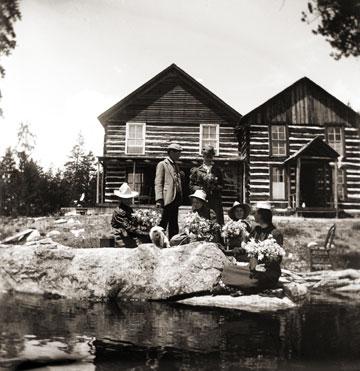

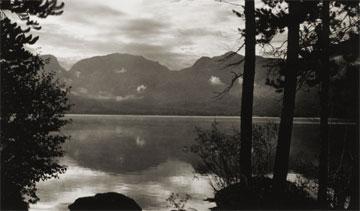
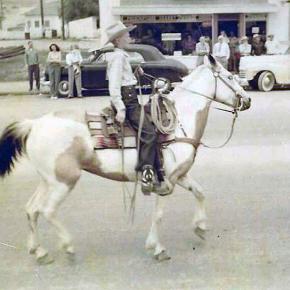

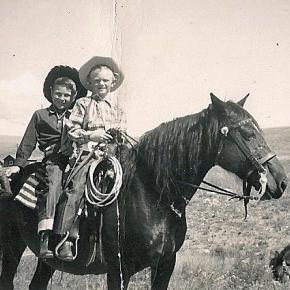
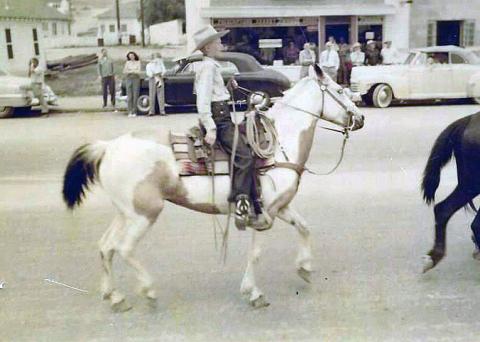 ,
,  ,
, 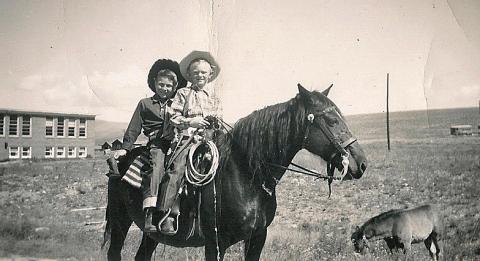
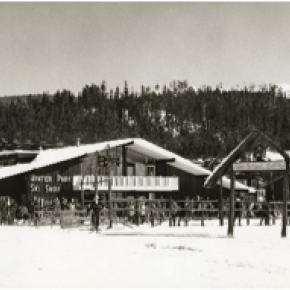
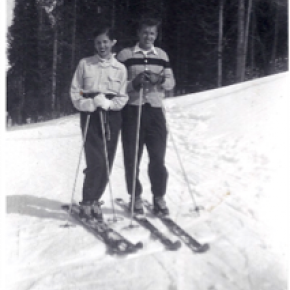
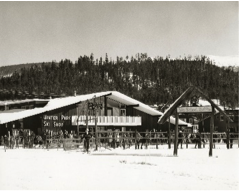 ,
, 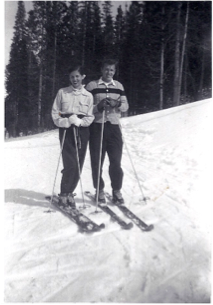
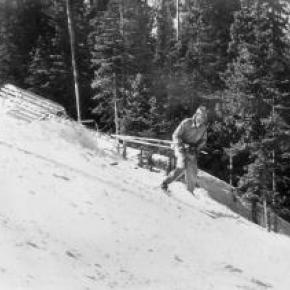
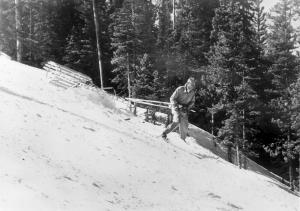
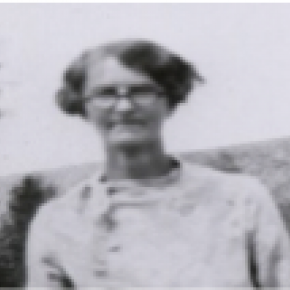
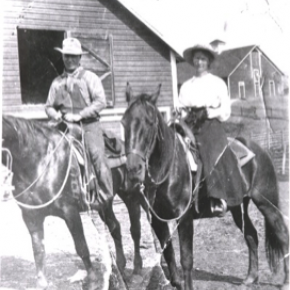
 ,
, 
